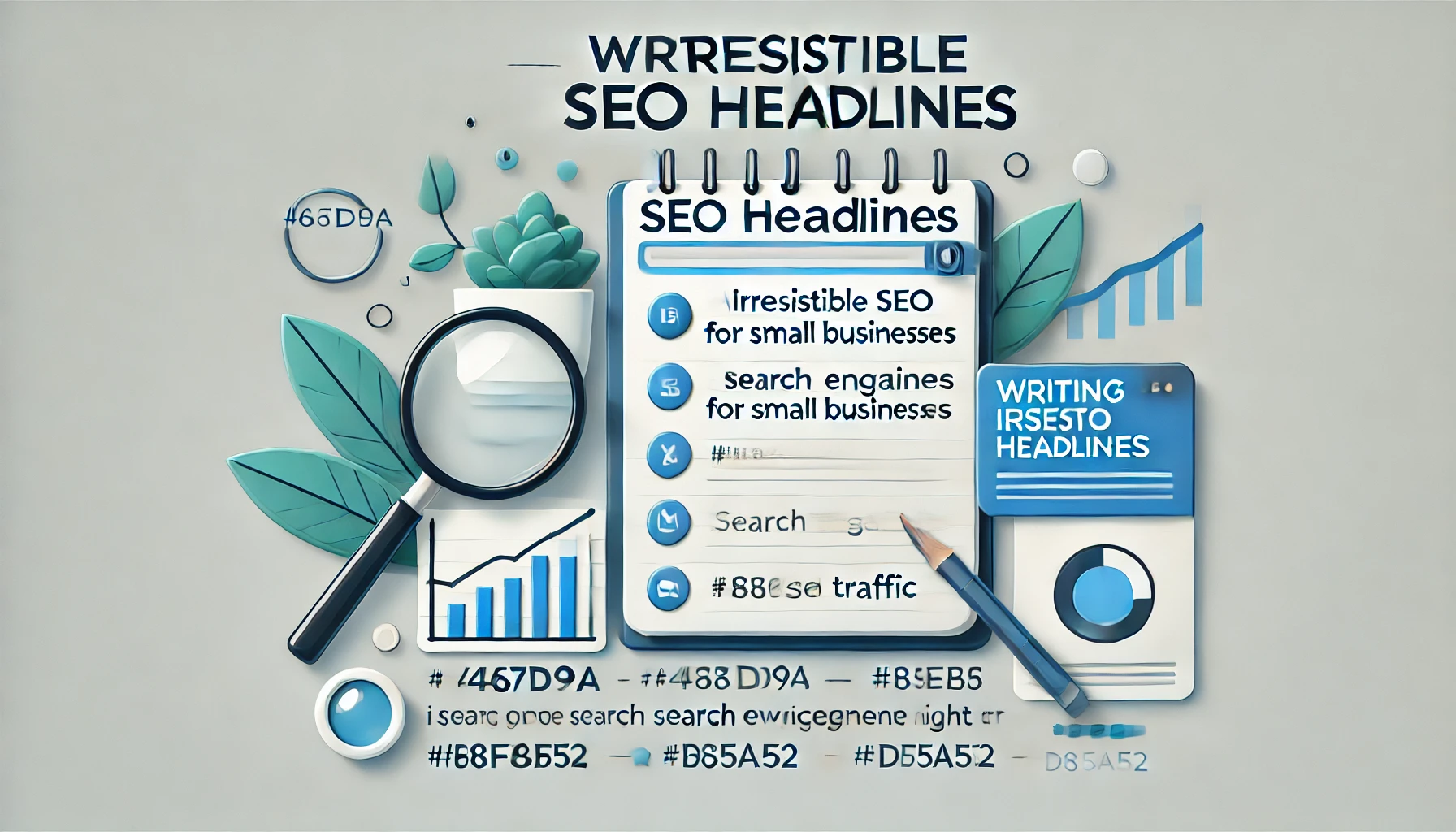
Getting people to click on your content can sometimes feel like an uphill battle. You might have created the most amazing blog post, but if the headline doesn’t grab attention, no one’s going to see it. Headlines are the first (and sometimes only) impression you get to make. They’re like your online shop window—if it’s boring or unclear, people will simply walk by. But if your headline is compelling and irresistible, it can pull in more clicks, boost your rankings, and get shared across the web.
In this guide, we’ll break down how to create SEO-optimised headlines that don’t just look good but also rank higher in search results and drive real engagement. We’ll cover what makes a good headline, the psychology behind the perfect headline, and how to use a mix of common, uncommon, emotional, and power words to nail it every time. Plus, we’ll analyse some sample headlines to show you what works and what doesn’t!
Why Headlines Matter for Small Businesses
For small businesses, time and resources are often limited. Every piece of content you create needs to pull its weight. That’s why headlines are so important—they’re your first opportunity to grab a potential customer’s attention and convince them to read on. A well-crafted headline can:
- Increase Click-Through Rates (CTR): A good headline attracts more clicks, leading to higher engagement.
- Boost Your SEO: Optimised headlines make it easier for Google to understand what your content is about.
- Encourage Shares: Headlines that resonate are more likely to be shared on social media, extending your reach.
According to studies, 8 out of 10 people will read a headline, but only 2 out of 10 will read the rest. So, if you’re not focusing on your headlines, you’re losing a big chunk of potential traffic.
The Anatomy of a Perfect SEO Headline
What makes a headline perfect? There’s no magic formula, but there are a few proven elements that you should include:
1. Character Count
Headlines with around 55 characters tend to perform best. This length is ideal for appearing fully in search results without getting cut off.
2. Word Count
Aim for 6-8 words. This keeps the headline concise but still detailed enough to communicate the message.
3. Word Mix
Use a combination of common, uncommon, emotional, and power words. Here’s the breakdown:
- 20-30% Common Words: These are everyday words that make your headline easy to read (e.g., “and,” “help,” “get”).
- 10-20% Uncommon Words: Words that aren’t used often but add interest and specificity (e.g., “boost,” “launch,” “accelerate”).
- 10-15% Emotional Words: Words that tap into emotions (e.g., “amazing,” “incredible,” “success”).
- At least one Power Word: Words that trigger action or urgency (e.g., “proven,” “guaranteed,” “exclusive”).
Example:
“Boost Small Business Growth with Proven Marketing Strategies”
- Common words: “Small,” “with”
- Uncommon words: “Boost,” “Growth”
- Emotional word: “Proven”
- Power word: “Strategies”
Understanding the Psychology of Headlines
To create irresistible headlines, you need to tap into psychology. Here are a few psychological triggers that encourage users to click:
1. Curiosity
People are naturally curious. Headlines that leave a question unanswered or promise to reveal something new will entice readers.
- Example: “The Secret to Boosting Your Business in 2024”
This headline makes the reader want to find out what the secret is.
2. FOMO (Fear of Missing Out)
No one likes feeling left out. Headlines that create urgency or exclusivity tap into FOMO.
- Example: “Don’t Miss Out: Top 5 Strategies for Small Business Growth”
The phrase “Don’t Miss Out” creates urgency and FOMO.
3. Emotion
Emotionally charged headlines connect with readers on a deeper level. Use words that evoke excitement, fear, or joy.
- Example: “Amazing Tips to Skyrocket Your Business in Weeks!”
“Skyrocket” and “Amazing” add emotional weight to the headline.
4. Social Proof
People trust what others are doing. Headlines that reference numbers or community actions can boost credibility.
- Example: “Why 10,000 Businesses are Switching to This Tool”
The large number adds credibility and makes the reader curious.
Creating SEO Headlines: Best Practices for Small Businesses
Follow these best practices to create headlines that rank and resonate:
1. Use Target Keywords
Incorporate your main keyword near the beginning of your headline. This helps search engines understand what your content is about.
- Example: If your target keyword is “Small Business Marketing,” a good headline might be:
“Proven Small Business Marketing Tips to Increase Sales”
2. Keep It Relevant
Your headline should clearly communicate what the article is about. Misleading headlines lead to high bounce rates, which can hurt your SEO.
3. Use Numbers
Headlines with numbers tend to get more clicks. Odd numbers work best, as they are perceived as more authentic.
- Example: “7 Proven Ways to Boost Your SEO in 2024”
4. Add a CTA (Call to Action)
Encourage readers to click by using action-oriented words like “Discover,” “Learn,” or “Find Out.”
5. Test and Optimise
Try different versions of your headline and see what performs best. Use tools like CoSchedule Headline Analyzer or AIOSEO for feedback.
Let’s give it a go shall we? Below you can see our journey creating a headline for Connect3ltd
Here’s a breakdown of why some headlines score better than others according to AIOSEO:
1. “Helping small business launch and grow” – 40/100
- Character Count: 33 characters—too short.
- Word Count: 6 words—good.
- Lacks Emotion and Power: There’s no emotional or power word, making it sound generic.
- Common Words Overuse: Almost all words are common, making it less impactful.

2. “Helping Small Businesses Grow with Tech” – 55/100
- Character Count: 40 characters—ideal.
- Word Count: 6 words—good.
- Lacks Emotion: The headline is descriptive but lacks emotion and urgency.
- Good Word Mix: Uses “Tech” as an uncommon word, making it slightly more appealing.
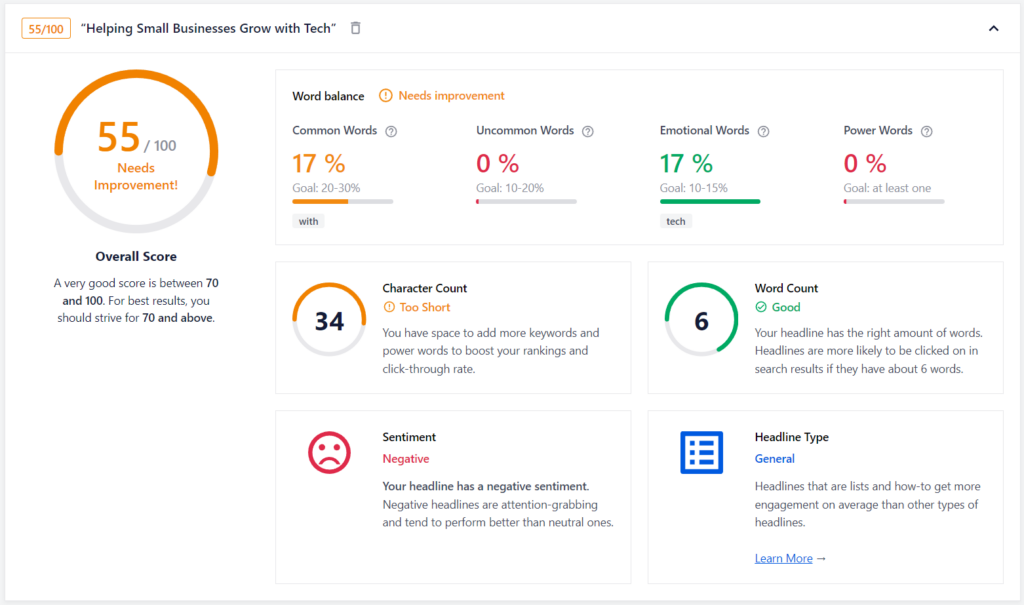
3. “Transforming Small Businesses with Innovative, Cost-Effective Technology Strategies” – 59/100
- Character Count: 68 characters—too long for SEO.
- Word Count: 8 words—borderline.
- Strong Use of Uncommon and Power Words: Words like “Innovative” and “Cost-Effective” add value, but it’s too long to be catchy.

4. “Accelerating Small Business Growth with Cutting-Edge, Cost-Effective Tech Solutions” – 74/100
- Character Count: 72 characters—too long.
- Word Count: 10 words—too many.
- High Uncommon Word Use: “Accelerating,” “Cutting-Edge” add uniqueness and appeal.
- Emotion: Uses emotional words like “Growth,” making it more engaging.
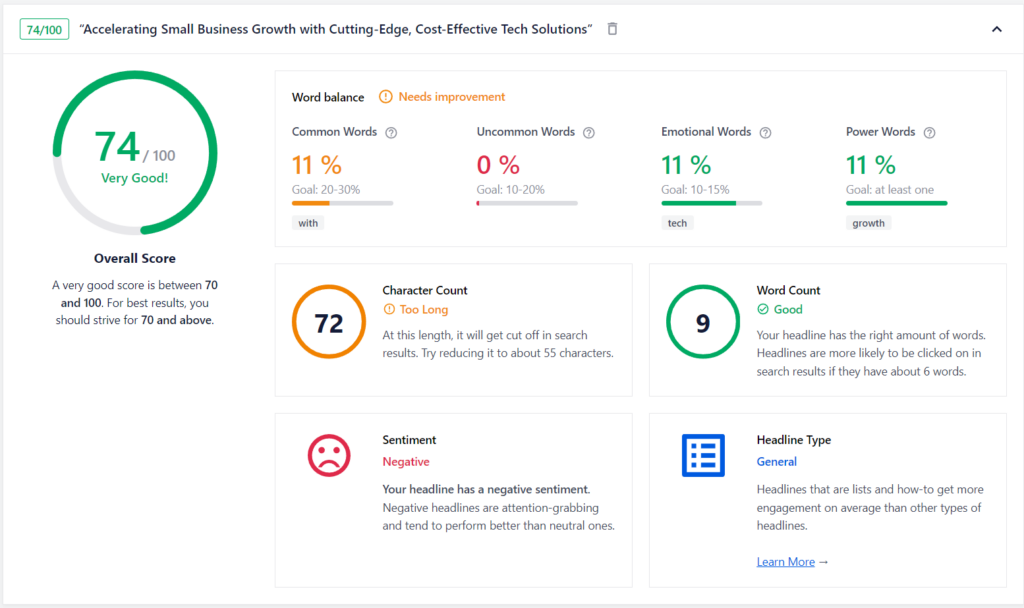
5. “Empowering Small Business Growth with Smart, Cost-Effective Tech” – 77/100
- Character Count: 63 characters—borderline.
- Word Count: 8 words—good.
- Emotion and Uncommon Words: “Empowering” and “Smart” add emotional and uncommon value, boosting the score.
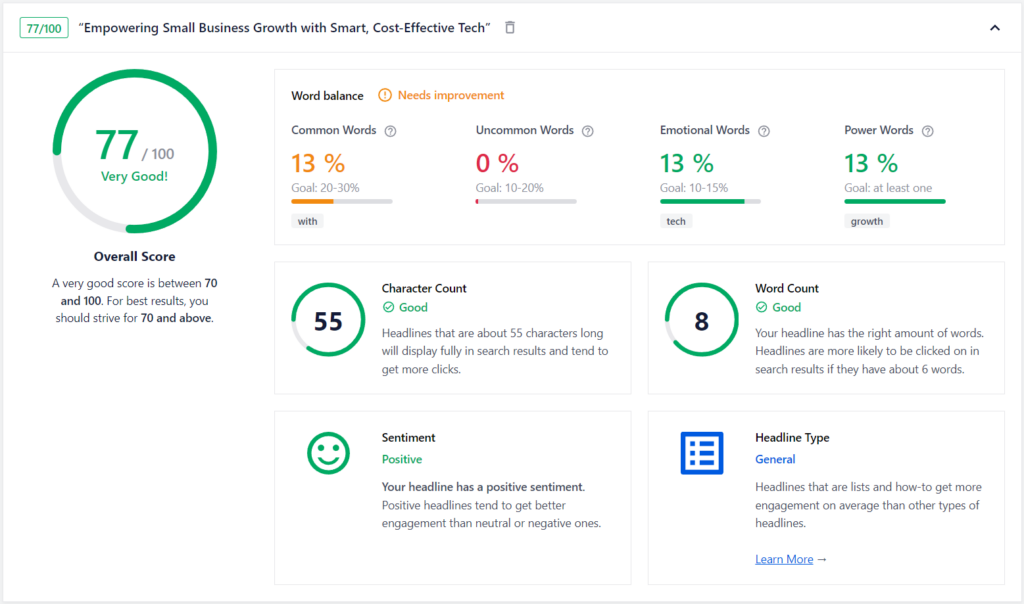
6. “Boosting Small Business Growth with Smart and Affordable Tech Solutions” – 85/100
- Character Count: 63 characters—borderline.
- Word Count: 8 words—good.
- Excellent Use of Power Words: “Boosting” is a powerful action word.
- Balance of Word Types: Combines common, uncommon, and emotional words effectively, making it the top performer.
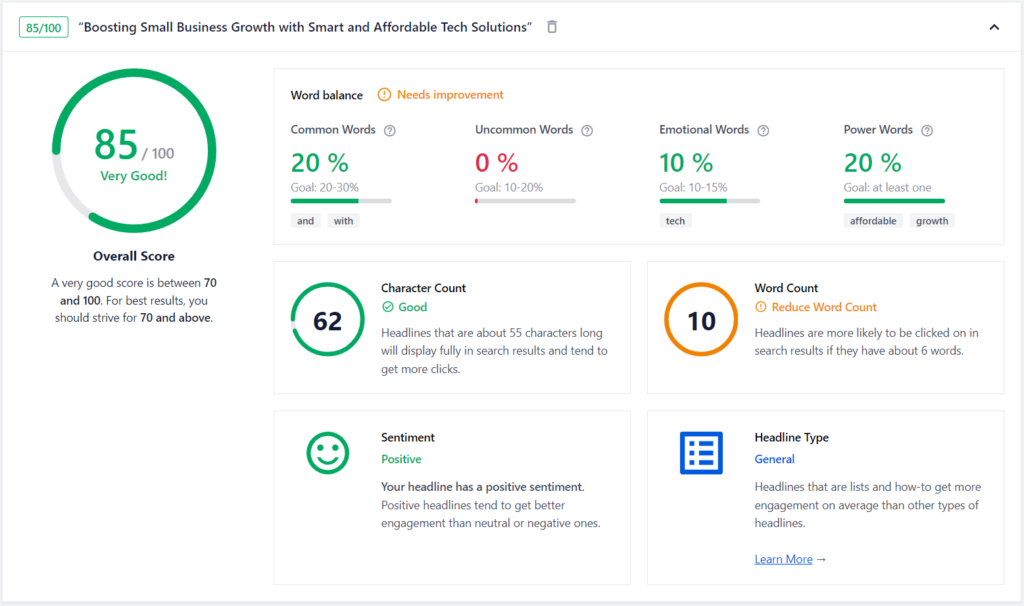
Here’s the headline that we’ve gone with for Connect3ltd, we hope you like it 🙂
“Boosting Small Business Growth with Smart and Affordable Tech Solutions”
Final Thoughts: Write Headlines That Stand Out and Rank High
Crafting the perfect headline takes practice, but it’s worth the effort. By using the right mix of words, tapping into psychology, and keeping SEO in mind, you can create headlines that not only grab attention but also drive traffic and boost your rankings.
Start experimenting, test your headlines, and watch your click-through rates soar!